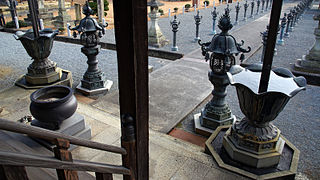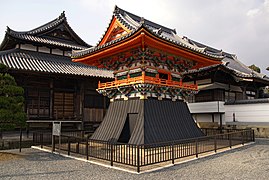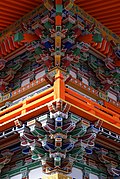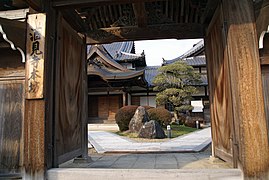Sagami-ji
The Sagami-ji ( Japanese 酒 見 寺 ) with the mountain name Senshō-zan ( 泉 生 山 ) is a temple of the Kōyasan branch ( 高 野山 派 ) of the Shingon direction of Buddhism in Kasai in Hyōgo Prefecture . According to traditional counting, it is the 29th temple on the New Saigoku Pilgrimage Route .
history
According to tradition, the temple was founded by priest Gyōki in 745. Later it belonged to the Sagami Shrine as a shrine sub-temple ( 神宮 寺 Jingūji ). He was promoted by Emperor Shōmu .
The Mineai-ki ( 峰 相 記 ), a description of the province from the end of the Kamakura period , says that it was one of the "Six Great Temples of Harima" ( 六大 寺 Rokudaiji ), and that the Sutras at the Sagami Shrine Daihan'nya ( 大 般若 経 ) and that it had a special relationship with the imperial court. The 3rd Tokugawa Shogun, Iemitsu , elevated the temple to the "Temple of the Red Seal" ( 御 朱 印 寺 Goshuin-dera ).
The Sagami-ji was frequently haunted by troops, burned down and was rebuilt, including during the civil war in the Tenshō era (1573–1592).
investment
You enter the spacious temple complex in the south through the Niō gate ( 仁王 門 Niō-mon ; 1 in the plan), i.e. through a gate that is designed with the two temple guards to the right and left of the passage. Here it is designed as a tower gate ( 楼門 Rōmon ). The current one dates back to 1825. A stone path lined with 21 bronze lanterns to the right and left leads to the main hall. You pass the large Jōgyōdō ( 常 行 堂 ) on the left , the Amida Hall, which is called Inzeidō ( 引 聲 堂 ; 2) here . Every year from September 10th the "Inze-Eshiki" ( 引 聲 会 式 ) is carried out for one week . This ceremony, which is only held here, dates back to 1011 and is said to go back to Priest Ennin . Behind it stands the Bokefuji-Kannon ( ぼ け 封 じ 観 音 ; 5). On the right side you can see the small Jizō pavilion ( 地 蔵 堂 Jizō-dō ; 3) and a little behind it on the right the treasure pagoda ( 多 宝塔 Tahōtō ; 4). It dates from 1662 and is registered as an Important Cultural Property of Japan .
At the end of the path there is the high main hall ( 本 堂 Hondō ; 6). Next to it stands the bell tower ( 鐘楼 Shōrō ; 7) on a pedestal, which, together with its bell ( 梵 鐘 Bonshō ), which, according to the inscription, dates from 1364, is registered as a cultural asset of the prefecture. It is believed to date from the same period as the Treasure Pagoda. To the left of the main hall there is the holy Benzaiten in a pond . The abbot and monk's quarters (A) are laid out in the north.
Directly to the west is the large Sumiyoshi Sagami Shrine ( 住 吉 酒 見 神社 ; S), which is one of the "Three Shrines of Harima" ( 播 磨 国 三 宮 Harmakoku sangū ).
photos
Remarks
- ↑ The others are the Engyō-ji ( 圓 教 寺 ), Hachijō-jii ( 八 葉 寺 ), Zuigan-jii ( 随 願 寺 ), Myōtoku-jii ( 妙 徳 寺 ), Shishaku-jii ( 神 積 寺 ), Fukō- jii ( 普光寺 ) and the Ichijō-ji .
literature
- Hyōgo-ken no rekishi sampo henshu iinkai (ed.): Sagami-ji . In: Hyogo-ken no rekishi sampo (ge). Yamakawa Shuppan, 2012. ISBN 978-4-634-24828-1 . Pp. 36 to 37.
Web links
Coordinates: 34 ° 56 ′ 8.5 ″ N , 134 ° 49 ′ 46.5 ″ E








